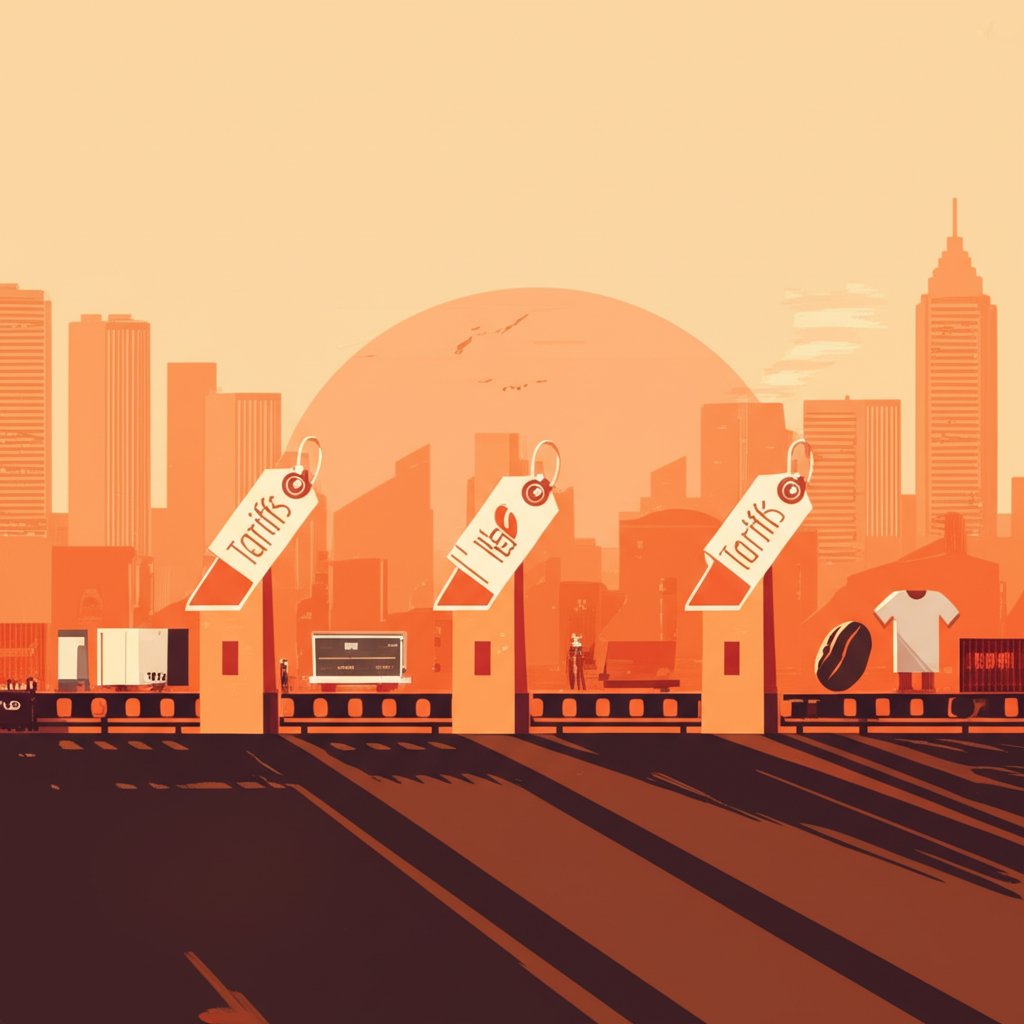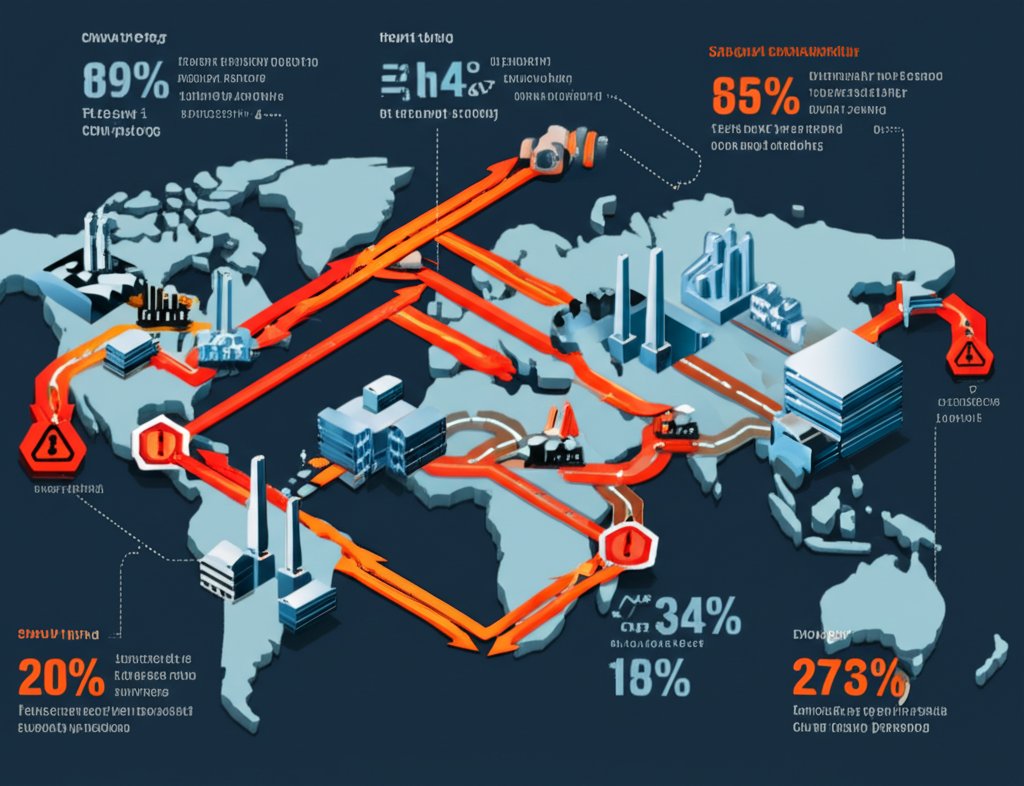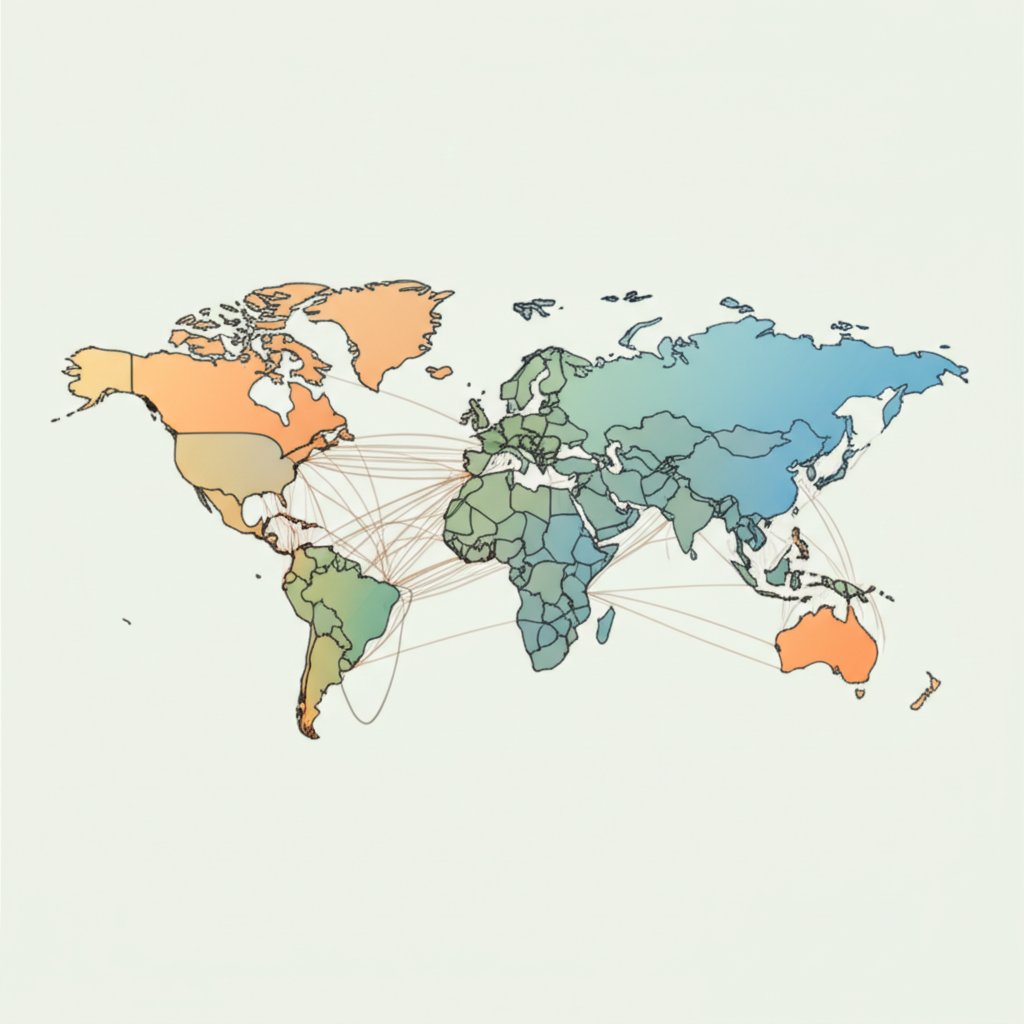
Understanding the Impact of Tariffs on Trade in a Shifting Global Economy
When you hear the word “tariff,” do you picture a distant government policy or something that affects your daily life? In reality, tariffs are at the heart of international trade—and their ripple effects reach businesses, consumers, and economies worldwide. But what are tariffs, and why do they matter so much in today’s interconnected world?
What Are Tariffs and Why Are They Used?
At their core, tariffs are taxes imposed by a government on goods and services imported from other countries. Imagine you’re a business importing steel to manufacture cars in the United States. If the government applies a 25% tariff on imported steel, the cost of those materials instantly rises. This extra cost can influence everything from the price of the final product to the competitiveness of domestic industries.
Governments use tariffs for several primary purposes:
- Protecting domestic industries: By making foreign goods more expensive, tariffs give local producers a competitive edge. For example, a tariff on imported steel can help domestic steelmakers maintain their market share against cheaper foreign competitors.
- Generating government revenue: Tariffs can be a significant source of income, especially in countries where other forms of taxation are limited. In the United States, for instance, customs duties brought in $41.6 billion in 2018 and rose to $71.9 billion in 2019[Investopedia].
- Serving as diplomatic or economic levers: Tariffs are often deployed as tools to influence the policies or behaviors of other nations. Recent examples include tariffs imposed to address concerns over national security, unfair trade practices, or as leverage in broader geopolitical negotiations[CFR].
Why Are Tariffs Making Headlines Now?
Sounds complex? The reality is even more nuanced. In today’s volatile geopolitical landscape, trade policy has become a powerful instrument for achieving both economic and political objectives. Recent years have seen a resurgence in tariff use, with major economies like the United States, China, and the European Union engaging in high-profile tariff disputes. These actions stem from a mix of motivations, including protecting strategic industries, addressing trade imbalances, and responding to perceived unfair competition.
This renewed focus on tariffs reflects growing skepticism about the benefits of free trade and rising concerns over national security, supply chain resilience, and domestic job protection. For example, recent U.S. tariffs on steel, aluminum, and a wide range of Chinese imports were justified by citing national security and efforts to rebalance trade deficits. Meanwhile, other countries have responded with their own tariffs, creating a dynamic and sometimes unpredictable global trade environment[Tax Foundation].
The Far-Reaching Impact of Tariffs on Trade
Why should you care about the impact of tariffs on trade? Because their consequences are far-reaching and multifaceted:
- They can raise prices for everyday goods, affecting consumers and businesses alike.
- They influence global supply chains, forcing companies to rethink sourcing and production strategies.
- They shape international relations and can escalate into full-scale trade wars, disrupting the global economy.
As we navigate the maze of modern trade policy, understanding tariffs and their effects is more important than ever. In the chapters ahead, we’ll explore how tariffs work, their immediate and long-term consequences, and what businesses and consumers can do to adapt in this rapidly changing landscape.

Understanding the Mechanics
When you shop for a new car or a pair of sneakers, do you ever wonder why some imported goods cost more than others? This price difference often traces back to tariffs—taxes that governments impose on foreign products. But how do these tariffs really work, and who ends up footing the bill?
Breaking Down the Types of Tariffs
Tariffs aren’t one-size-fits-all. In fact, there are several types of tariffs used in international trade, each with its own structure and impact on prices. Here’s a quick rundown:
- Ad Valorem Tariffs: These are calculated as a percentage of the value of the imported good. Imagine a 15% tariff on a $40,000 car—suddenly, that car costs $46,000 for the buyer. This type is common in sectors like automobiles and electronics, making imports noticeably pricier for consumers[Investopedia].
- Specific Tariffs: Instead of a percentage, these are fixed fees charged per unit of an imported product. For example, a country might impose a $15 tariff on every pair of imported shoes or a $300 tariff on each imported computer. This approach is straightforward and often used for easily measured goods.
- Compound Tariffs: These combine both ad valorem and specific tariffs. For instance, a country could levy a 5% ad valorem tariff plus $10 per unit, blending both value-based and quantity-based charges.
Some countries also use tariff-rate quotas, where tariffs jump after a certain volume of imports is reached, but these are less common than the main three above[CFR].
Who Really Pays for Tariffs?
It’s tempting to think that foreign exporters bear the cost of tariffs, but in reality, the burden often falls on domestic businesses and consumers. Here’s how it works: when a tariff is applied, importers must pay the tax to bring goods into the country. To offset these added costs, importers typically raise their prices. That means:
- Consumers pay more for imported goods, from electronics to clothing to food products.
- Businesses that rely on imported materials or components face higher production costs, which can also lead to higher prices for finished products.
For example, after the United States imposed a 25% tariff on certain imports, the price of affected consumer goods and business equipment rose accordingly, with estimates showing a near-term increase of up to 2.2% for consumer goods and 9.5% for investment goods if tariffs are fully passed on to buyers[FRBSF].
Immediate Economic Effects: How Tariffs Affect Trade
So, what are the immediate consequences when tariffs are introduced or raised?
- Higher prices for imports: Tariffs make foreign goods more expensive, which can reduce demand for those products.
- Boost for domestic industries: With imports costing more, domestic producers may gain a competitive edge. You’ll notice local products can become more attractive to consumers, even if they are slightly more expensive than foreign alternatives.
- Increased costs for import-reliant businesses: Companies that depend on imported parts or raw materials face higher input costs, which can squeeze profit margins or force price hikes down the line.
- Potential for inflation: When tariffs are widespread or target essential goods, the overall price level in the economy can rise, pushing up the cost of living.
In short, while tariffs are designed to protect domestic industries and generate revenue, their costs are often passed along the supply chain, ultimately landing on the shoulders of consumers and businesses at home[Investopedia]. This dynamic is at the heart of how tariffs affect trade, shaping the decisions of buyers, sellers, and policymakers alike.
Next, let’s explore how these changes ripple through the intricate web of global supply chains, creating new challenges for businesses worldwide.

The Ripple Effect
Imagine you’re running a business that relies on a steady stream of parts from overseas. Suddenly, a new round of tariffs is announced—costs spike, timelines shift, and your carefully laid plans are thrown into disarray. Sounds complex? That’s the reality many companies face as tariffs and supply chains become increasingly intertwined in today’s unpredictable trade environment.
How Tariffs Disrupt Supply Chains
Tariffs don’t just raise prices—they create a chain reaction that ripples across every stage of the supply chain. When governments impose new tariffs or adjust existing ones, the rules of the game change overnight. Businesses are left scrambling to adapt, and the uncertainty can undermine even the most sophisticated supply chain strategies. According to supply chain experts, the most immediate impact is on demand forecasting and inventory planning. Companies accustomed to just-in-time ordering—where goods arrive precisely when needed—suddenly find that their forecasts are less reliable, leading to either costly overstocking or risky shortages.
- Demand Forecasting: Tariffs create uncertainty about future costs and demand, making it harder to predict what, how much, and when to order.
- Inventory Management: With unpredictable price changes and potential supply interruptions, companies may over-order to hedge against future tariffs or under-order to avoid excess costs—either way, efficiency suffers.
- Production Planning: Fluctuating input costs and delivery times force manufacturers to constantly adjust schedules, sometimes pausing or canceling orders altogether.
For example, a business that once imported goods into the U.S. and then distributed them to Canada may now reroute shipments directly to Canada to avoid double tariffs, completely reorganizing its logistics and distribution strategy. Others invest in new facilities in alternative countries, only to face fresh tariffs in those regions, prompting a continual reassessment of sourcing and market focus.
Operational Challenges: Rising Costs and Delays
As tariffs disrupt the flow of goods, businesses encounter a host of operational challenges:
- Increased Transportation Costs: Companies may need to reroute shipments or use alternative ports, driving up logistics expenses.
- Supplier Shifts: To bypass tariffs, businesses often seek new suppliers in different countries. However, this switch can introduce delays and uncertainty, as new relationships take time to establish and stabilize.
- Production Delays: Unpredictable tariffs can cause companies to pause or cancel orders, leading to gaps in production and missed delivery deadlines.
These disruptions are compounded by the need for greater flexibility and resilience. As one industry leader put it, “The pandemic taught us we need to allow flexibility in our supply chains, maybe at the cost of pennies.” In other words, building in extra capacity or backup suppliers can help, but it often comes at a price[Thomson Reuters].
Maintaining Quality Amid Supplier Changes
Here’s a critical question: when you pivot to a new supplier to avoid tariffs, how do you ensure your product quality doesn’t suffer? The answer lies in robust quality control and inspection processes. Every new supplier brings unknowns—different raw materials, production methods, and quality standards. Without careful vetting and ongoing oversight, you risk introducing defects or inconsistencies into your products.
| Key Steps for Quality Assurance When Switching Suppliers |
|---|
|
Expert resources, such as comprehensive guides on pre-shipment inspection and quality control, are invaluable for businesses navigating tariff-driven supply chain disruption. They offer actionable checklists and best practices for vetting new suppliers, conducting effective inspections, and safeguarding product integrity—even as you adapt to a shifting global landscape[LinkedIn].
Building Resilience in a High-Tariff World
Ultimately, the impact of tariffs on supply chains is a test of resilience. While disruptions are inevitable, companies that invest in flexible sourcing strategies, robust quality control, and proactive risk management are better equipped to weather the storm. The next chapter will dive deeper into the economic consequences of these disruptions, exploring how higher costs and delays ultimately affect consumers and the broader economy.
Economic Consequences
When you’re shopping for groceries or a new car, have you ever noticed prices creeping up and wondered why? One hidden culprit is often tariffs—taxes on imported goods that can quietly drive up the cost of everyday items. But how exactly do tariffs and consumer prices connect, and what are the broader economic effects of tariffs on households and industries?
How Tariffs Act as a Hidden Tax on Consumers
Tariffs are often described as a tax on imports, but the reality is that the cost rarely stops at the border. Instead, it’s passed down the supply chain, landing squarely on the shoulders of businesses and, ultimately, consumers. Imagine you’re buying a washing machine that used to cost $500. After a 25% tariff, the price could jump to $625—money out of your pocket for the same product. This isn’t just theory: studies show that, in practice, import prices often increase by nearly the full amount of the tariff, with most of the extra cost passed directly to consumers.
- Tariffs increase the price of imported goods, making them less affordable for consumers.
- Domestic producers may also raise their prices, taking advantage of reduced foreign competition.
- The result? A broad-based rise in the cost of living, as both imported and domestic goods become more expensive.
For example, a 25% tariff applied across all imported consumer goods could raise consumer prices by about 2.2%, according to the Federal Reserve Bank of San Francisco[FRBSF]. While that might sound small, it adds up quickly when spread across everything from clothing to electronics and groceries.
The Mixed Impact on Domestic Industries
At first glance, tariffs seem to offer a lifeline to domestic industries by shielding them from foreign competition. But the reality is more nuanced. Some businesses do benefit, but many others—especially those relying on imported materials—face higher costs and shrinking profit margins.
- Winners: Industries that compete directly with imports (like steel or textiles) may see a boost in sales and prices, as foreign goods become less competitive.
- Losers: Sectors that rely on imported components (such as auto manufacturing or electronics) find their costs rising, reducing their ability to compete at home and abroad.
Imagine a U.S. car manufacturer that imports parts from overseas. After tariffs, the cost of those parts rises, forcing the company to choose between absorbing the loss or raising prices for consumers. Either way, competitiveness suffers. In some cases, businesses may try to switch to domestic suppliers, but this isn’t always feasible—especially for specialized or unavailable components. The result? Some domestic producers benefit, but often at the expense of other businesses and the broader economy[Tax Foundation].
Comparing Prices Before and After Tariffs
What does all this mean for your wallet? Let’s look at a comparison table that illustrates how tariffs can affect the prices of everyday goods:
| Product | Pre-Tariff Price | Tariff Rate | Post-Tariff Price | Notes |
|---|---|---|---|---|
| Washing Machine | $500 | 20% | $600 | Example from 2018 U.S. tariffs |
| Imported Car | $30,000 | 25% | $37,500 | Estimated impact if costs fully passed to buyers |
| Clothing (per item) | $50 | 10% | $55 | Typical apparel tariff scenario |
| Groceries (monthly basket) | $400 | 5% | $420 | Estimated impact for food imports |
These estimates show how even small percentage increases can add up over time, especially for big-ticket items or essential goods. For families living paycheck to paycheck, these price hikes can mean tough choices about what to buy—or what to cut back on.
Broader Economic Effects: Beyond the Price Tag
Tariffs don’t just affect what you pay at the store. They ripple through the economy in several other ways:
- Reduced consumer spending: Higher prices mean less disposable income, which can slow overall economic growth.
- Lower business investment: As costs rise and uncertainty grows, companies may delay or cancel new projects.
- Job market shifts: While some jobs may be created in protected industries, others are lost in sectors that face higher costs or shrinking export markets due to retaliatory tariffs.
- Inflationary pressures: Widespread tariffs can push up inflation, eroding purchasing power for everyone.
According to J.P. Morgan Research, a 10% universal tariff could boost U.S. personal consumption expenditures (PCE) prices by 1–1.5% in a single year, with the inflationary effects concentrated in the middle quarters[J.P. Morgan]. The resulting hit to purchasing power could even push real disposable income growth into negative territory, meaning that after accounting for inflation, consumers have less money to spend than before.
Key Takeaways for Consumers and Businesses
- Tariffs are a hidden tax that often falls on domestic consumers, raising the cost of living.
- Some domestic industries may benefit, but others—especially those dependent on imported inputs—face higher costs and reduced competitiveness.
- The economic effects of tariffs go beyond prices, influencing business investment, job opportunities, and overall economic growth.
As you can see, the impact of tariffs on trade is felt not just at the border, but at the cash register, in the workplace, and across the broader economy. In the next chapter, we’ll explore how businesses can adapt and develop strategies to navigate these trade barriers and protect both their bottom line and their customers.

Navigating Trade Barriers
When tariffs threaten your bottom line, how do you stay ahead of the curve? The answer lies in a mix of proactive planning, supply chain agility, and a relentless focus on quality. Let’s break down the most effective business strategies for tariffs, so you can mitigate tariff impact and build resilience in a turbulent global marketplace.
1. Map and Monitor Your Supply Chain for Vulnerabilities
Sounds overwhelming? Start with visibility. Many businesses underestimate how deeply tariffs can ripple through their supplier networks—sometimes affecting not just direct vendors, but second- and third-tier suppliers as well. By mapping your entire supply chain, you’ll uncover hidden dependencies and spot where tariff risks are most acute. Use digital supply chain mapping tools or supplier databases to document:
- Where each supplier is located and which regions are exposed to new tariffs
- Which parts or materials are sourced from each supplier
- Contact details and backup plans for each site
This foundational step makes it easier to react quickly when trade policies shift, and lays the groundwork for smarter scenario planning and risk mitigation.
2. Diversify and Restructure Your Supplier Base
Imagine relying on a single overseas supplier—then a new tariff suddenly makes their goods prohibitively expensive. To avoid this scenario, diversify your sourcing:
- Alternative Suppliers: Seek out vendors in regions not affected by current tariffs. Use supplier networks, trade associations, and industry databases to expand your options.
- Nearshoring and Reshoring: Consider moving production closer to home or within tariff-free trade blocs. While this can require upfront investment, it reduces exposure to future trade shocks and often shortens logistics timelines.
- Supplier Partnerships: Build closer, partnership-oriented relationships with fewer, more reliable suppliers. This approach can reduce variability and improve quality control over time.
Supply chain restructuring is a comprehensive strategy that may also involve reviewing country-of-origin determinations and leveraging free trade agreements to optimize your tariff exposure.
3. Renegotiate Contracts and Clarify Tariff Liabilities
When tariffs hit, who pays the extra cost—you or your supplier? Don’t leave it to chance. Review and renegotiate procurement contracts to:
- Clearly define tariff responsibilities and cost-sharing mechanisms
- Incorporate change-in-law clauses to address future tariff changes
- Negotiate creative solutions, such as dual sourcing or price adjustment triggers
Transparent contracts ensure all parties are aligned and help prevent disputes if trade policies change unexpectedly.
4. Leverage Customs Programs and Duty Relief Mechanisms
Did you know there are official programs designed to ease tariff burdens? Explore options such as:
- Foreign-Trade Zones (FTZs): Designated areas where goods can be imported, processed, and re-exported without incurring tariffs until they enter the domestic market.
- Duty Drawback: Programs that refund duties paid on imported goods that are later exported.
- Temporary Importation under Bond (TIB): Allows temporary imports without immediate payment of duties, ideal for goods used in short-term projects or exhibitions.
- Trusted Trader Programs: Partnerships with customs authorities (like CTPAT or AEO) can provide expedited clearance and reduced import costs.
These mechanisms can offer significant cost savings and operational flexibility.
5. Invest in Technology for Real-Time Visibility and Scenario Planning
Tariffs can change overnight. How do you keep up? Advanced supply chain visibility solutions—powered by AI and predictive analytics—can help you monitor regulatory changes, assess supplier risk, and model the financial impact of different tariff scenarios. This technology allows you to:
- Receive automated alerts on tariff updates
- Run ‘what-if’ simulations to inform procurement and pricing strategies
- Identify vulnerabilities before they disrupt your operations
With these tools, you’ll be able to act quickly and decisively, rather than scrambling to react after the fact.
6. Prioritize Supplier Quality and Pre-Shipment Inspection
Switching suppliers to avoid tariffs? Don’t let quality slip through the cracks. Every new supplier introduces risks—different standards, unfamiliar processes, and potential for defects. To safeguard product integrity:
- Implement robust supplier quality management systems and audits
- Conduct pre-shipment inspections and material testing before goods leave the factory
- Leverage comprehensive guides and expert resources on inspection best practices to set clear criteria and avoid costly surprises
For a detailed, step-by-step approach to vetting and managing new suppliers—especially in high-tariff environments—resources like Eagle Eyes’s pre-shipment inspection guide are invaluable. These guides empower you to ensure every dollar spent on tariffs is matched by goods that meet your quality standards, maximizing your return on investment and protecting your reputation.
7. Advocate and Stay Engaged
Finally, don’t underestimate the value of advocacy. Engage with industry associations or government representatives to stay informed about potential tariff changes and to participate in exclusion processes or policy discussions. Proactive advocacy can sometimes yield tariff relief or influence future trade negotiations[FTI Consulting].
Checklist: Mitigating Tariff Impact—Action Steps for Your Business
| Action | Purpose |
|---|---|
| Map supply chain and assess vulnerabilities | Identify risk exposure and plan alternatives |
| Diversify suppliers and consider nearshoring | Reduce dependency and enhance resilience |
| Renegotiate contracts | Clarify cost responsibilities and improve flexibility |
| Utilize customs programs (FTZ, duty drawback) | Lower tariff-related costs |
| Invest in supply chain visibility technology | Enable real-time monitoring and scenario planning |
| Implement supplier quality management and pre-shipment inspection | Ensure product integrity during supplier shifts |
| Engage in advocacy and industry partnerships | Stay ahead of policy changes and seek relief |
By combining these business strategies for tariffs, you’ll not only mitigate tariff impact but also position your company for long-term success in a world where trade barriers are the new normal. Up next, we’ll examine how geopolitical tensions and retaliatory tariffs are shaping the broader landscape of international trade policy—and what that means for your business moving forward.
Tariffs and International Relations
When you hear about tariffs in the news, do you picture spreadsheets and shipping containers—or do you see them as chess pieces in a high-stakes global game? In reality, tariffs and international relations are deeply intertwined, shaping not just economies but the very balance of power between nations. Let’s explore how countries wield tariffs as strategic tools, how these actions can spark trade wars, and why the consequences ripple far beyond the negotiating table.
Tariffs as Tools of Influence and National Security
Why do governments reach for tariffs when tensions rise? Sometimes, it’s about protecting key industries—like pharmaceuticals or semiconductors—that are vital for national security. Other times, tariffs serve as leverage in diplomatic negotiations, pressuring trading partners to alter policies or address perceived unfair practices. For instance, the U.S. has imposed high tariffs on Chinese electric vehicles and semiconductors, citing both economic and security concerns. These measures are rarely just about economics; they’re signals—sometimes warnings—sent across borders[The Hartford].
- Protecting strategic industries: Tariffs can shield sectors considered essential for a country’s technological edge or defense capabilities.
- Safeguarding national security: By limiting reliance on foreign suppliers—especially from rival nations—governments aim to reduce vulnerabilities in critical supply chains.
- Addressing unfair trade practices: Tariffs may be enacted in response to issues like intellectual property theft, forced technology transfer, or subsidized exports that distort competition.
But these moves rarely go unanswered. In today’s volatile climate, tariff actions are often met with swift retaliation, setting the stage for escalating trade disputes.
The Escalation Cycle: Retaliatory Tariffs and Trade Wars
What happens when one country imposes tariffs? The affected nation often responds in kind—sometimes targeting politically sensitive sectors to maximize pressure. This tit-for-tat dynamic can quickly spiral into a full-blown trade war, where both sides keep raising barriers in an attempt to outmaneuver each other.
- Retaliatory tariffs: Countries hit by tariffs frequently impose their own duties on imports from the initiator, affecting everything from agriculture to technology products.
- Trade wars: As rounds of tariffs accumulate, entire industries can be caught in the crossfire. The 2018–2020 U.S.-China trade dispute saw tariffs imposed on hundreds of billions of dollars’ worth of goods, with repercussions for global supply chains and consumer prices[Investopedia].
- Global ripple effects: Even countries not directly involved can suffer as trade flows shift, prices rise, and uncertainty grows.
History offers clear examples. The Smoot-Hawley Tariff Act of 1930 led to a wave of retaliatory tariffs worldwide, deepening the Great Depression. More recently, the rapid escalation of tariffs between the U.S., China, Canada, and Mexico has disrupted trade patterns and strained diplomatic relations[USC Law for Business].
Destabilizing the Global Economic Order
Why do trade wars and tariffs matter for the global economy? Because they introduce uncertainty—making it harder for businesses to plan, invest, or expand. When major economies engage in tariff battles, global supply chains are rerouted, investment slows, and markets become more volatile. For example, the U.S. tariffs enacted in 2025 led to a sharp decline in global equity values and heightened recession risks in multiple countries[USC Law for Business].
- Reduced trust and cooperation: Prolonged disputes can undermine international institutions like the World Trade Organization, weakening the frameworks that have underpinned decades of global growth.
- Fragmented trade blocs: As countries seek to shield themselves, they may form regional alliances or exclusive trade agreements, leading to a more divided and less predictable global economy.
- Increased business risk: For companies, heightened tariffs mean higher costs, supply chain disruptions, and the need for constant adaptation to shifting rules.
Imagine you’re a business leader trying to forecast demand or source components. Each new tariff announcement can upend your plans, making long-term investment decisions fraught with risk. For consumers, the result is often higher prices and fewer choices at the store.
Looking Ahead: The Ongoing Role of Tariffs in International Relations
Tariffs and international relations will remain closely linked as nations pursue a mix of economic, security, and political objectives. While tariffs can sometimes achieve short-term goals, their use as blunt instruments often leads to unintended consequences, including trade wars and global instability. As the next chapter will explore, these trends are reshaping the future of global commerce, challenging businesses and policymakers to adapt in an increasingly fragmented world.

The Future of Tariffs
When you look ahead, do you see a world seamlessly connected by trade—or a patchwork of competing blocs and shifting alliances? The future of tariffs is shaping the answer, as new trade barriers and evolving policies drive profound changes in how countries and companies do business. Let’s break down what these global commerce trends mean for the long-term outlook of international trade, supply chains, and business strategy.
Will the Global Economy Become More Fragmented?
Imagine a world where products once flowed freely across continents, but now face a maze of tariffs, regulations, and political roadblocks. Recent tariff escalations—such as the sweeping measures implemented by the United States in 2025—have already pushed global trade into new territory. According to leading economic research, these tariffs raised the effective U.S. import rate from below 3% to nearly 30% in some scenarios, and tit-for-tat retaliation pushed bilateral U.S.-China tariffs to around 125%. The result? Global trade flows contracted by as much as 8.5%, with the sharpest declines in sectors deeply embedded in cross-border value chains like electronics and transport equipment[CEPR].
- Fragmentation: Instead of one integrated global marketplace, trade is increasingly segmented along geopolitical lines. Countries are forming tighter regional alliances, as seen in the strengthening of North American, European, and Asian trade blocs.
- Selective Globalization: Rather than full-scale deglobalization, most experts see a shift toward “selective globalization,” where countries maintain open trade within trusted networks but impose barriers on rivals or in strategic sectors[IAGAM].
For businesses, this means navigating a more complex regulatory landscape, with different rules, standards, and tariffs depending on the region or trading partner.
The Rise of Regional Trade Blocs and Strategic Alliances
Why are regional trade blocs gaining ground? In response to tariff uncertainty and geopolitical friction, countries are doubling down on agreements with close neighbors or strategic allies. For example, the U.S.-Mexico-Canada Agreement (USMCA) has become a cornerstone for North American supply chains, while Asian nations are strengthening ties through pacts like the Regional Comprehensive Economic Partnership (RCEP).
- Resilient Supply Chains: By sourcing from within their own region or from allied countries (“friendshoring”), businesses can reduce exposure to sudden tariff hikes and political disruptions.
- Government Incentives: Many governments are now offering subsidies, tax breaks, and policy support to encourage domestic or regional production in critical sectors like semiconductors, pharmaceuticals, and electric vehicles.
These developments signal a long-term trend toward regionalization, where supply chains are shorter and more insulated from global shocks—but potentially less efficient and more costly.
Reshoring, Nearshoring, and the Restructuring of Global Value Chains
Are companies really bringing manufacturing back home? The answer is nuanced. While some firms are reshoring (returning production to their home country), many are embracing nearshoring (moving production to nearby, lower-cost countries) or friendshoring (relocating to allied nations). Practical examples include TSMC building semiconductor facilities in the U.S. and Japan, and Apple shifting a portion of its iPhone assembly to India. However, full disengagement from established manufacturing hubs like China remains challenging due to cost and scale advantages[IAGAM].
- Supply Chain Diversification: Companies now prioritize spreading risk by developing multiple supplier relationships in different regions.
- Balancing Cost and Security: While moving production closer to home can reduce tariff exposure and increase resilience, it may also raise costs and introduce new operational challenges.
Despite these shifts, true deglobalization is unlikely. Instead, the future points toward a hybrid model—global, but with strategic redundancies and strong regional clusters.
How Businesses Are Adapting for Long-Term Resilience
How do you prepare for a world where trade rules can change overnight? Leading companies are rethinking their global value chain strategies to build flexibility and reduce vulnerability to tariff shocks:
- Scenario Planning: Firms use sophisticated models to anticipate the effects of new tariffs and identify alternative sourcing strategies.
- Investment in Digital Infrastructure: Enhanced supply chain visibility and real-time data analytics help companies monitor shifting trade policies and respond quickly to disruptions.
- Focus on Quality and Compliance: As supply chains diversify, maintaining consistent quality and meeting regulatory requirements in multiple regions becomes even more critical.
Policymakers, too, are shifting their focus—from maximizing efficiency and cost savings to promoting resilience, regional growth, and sustainability in the face of ongoing trade tensions[CEPR].
Key Takeaways: The Evolving Landscape of Global Trade
- The future of tariffs will likely feature higher, more targeted trade barriers, reshaping global commerce trends.
- Regional trade blocs and alliance-based supply chains are on the rise, offering security but challenging global efficiency.
- Businesses that invest in diversification, digital tools, and quality assurance will be best positioned to thrive amid uncertainty.
As the next chapter will summarize, understanding and adapting to these long-term shifts is essential for anyone looking to succeed in international trade’s new era.
Conclusion
When you reflect on the journey through tariffs and global commerce, do you see just a series of taxes and regulations—or a complex web of risks, opportunities, and decisions that shape the fate of every business and consumer? The impact of tariffs on trade isn’t just about higher prices at the checkout. It’s about how companies adapt, how supply chains evolve, and how everyone—from CEOs to everyday shoppers—navigates a world in flux.
Key Insights: Tariffs Transform Every Link in the Trade Chain
- Tariffs are more than taxes: They’re levers of economic policy, tools for national security, and signals in geopolitical negotiations. Their effects ripple through global supply chains, business strategies, and household budgets.
- Costs are passed on: Whether you’re a business importing raw materials or a consumer buying finished goods, tariffs often translate into higher prices and tighter margins.
- Supply chains are under pressure: Companies must constantly reassess sourcing, inventory, and production plans to stay competitive and resilient in the face of shifting trade barriers.
- Winners and losers emerge: While some domestic industries gain protection, others—especially those reliant on global inputs—face new challenges and must innovate or pivot to survive.
Why Proactive Risk Management Matters
Sounds overwhelming? Imagine trying to predict your costs, manage your suppliers, and keep customers happy when tariffs can change overnight. That’s why understanding and proactively managing tariff risks isn’t just smart—it’s essential for long-term success. Businesses that thrive are those that:
- Stay informed about evolving trade policies and geopolitical trends
- Invest in scenario planning and flexible sourcing strategies
- Prioritize operational efficiency and cost control
- Emphasize quality control in international trade to avoid costly mistakes
For example, as highlighted in recent analyses, companies that regularly assess their competitive position and pressure-test major decisions are better equipped to respond quickly—whether that means shifting production, renegotiating contracts, or exploring new markets .
Quality Control: Your Shield Against Tariff-Driven Risk
Imagine paying high tariffs on a shipment, only to discover the goods are defective or non-compliant. In a high-tariff environment, every dollar spent carries more weight—and every mistake is magnified. That’s where robust quality control in international trade becomes your best defense. Strong quality assurance processes help you:
- Verify that products meet regulatory and customer standards before shipment
- Reduce the risk of costly returns, fines, or reputational damage
- Build trust with clients, partners, and investors
- Streamline operations for long-term sustainability and efficiency
Comprehensive guides on pre-shipment inspection and supplier vetting offer actionable steps to protect your investment and maximize the ROI on every container, especially when tariffs amplify financial risk. Leveraging these resources ensures that your capital—and your tariff payments—are only committed to goods that meet your standards, preserving profitability even as trade barriers rise.
Looking Forward: Agility and Expertise Win the Day
As the global trade landscape continues to evolve, agility and informed decision-making will separate the winners from the rest. Whether you’re a business leader, supply chain manager, or importer, embracing expert guidance and proven best practices in quality control will help you navigate uncertainty and seize new opportunities.
In a world where tariffs can shift overnight and supply chains are constantly tested, the most successful organizations will be those that combine strategic foresight with operational excellence. By understanding the full impact of tariffs on trade—and taking proactive steps to manage both cost and quality—you’ll be ready to thrive, no matter how the maze of global commerce twists and turns.
Frequently Asked Questions About the Impact of Tariffs on Trade
1. What are the main effects of tariffs on trade?
Tariffs raise the cost of imported goods, often resulting in higher prices for consumers and businesses. They can protect domestic industries but may also disrupt global supply chains, reduce competitiveness for companies relying on imports, and influence international relations by triggering retaliatory measures.
2. How do tariffs cause trade problems?
Tariffs can lead to increased costs, slower economic growth, and reduced profits for businesses. They may also contribute to job losses in sectors dependent on imported materials and create global tensions by prompting retaliatory tariffs from other countries.
3. Who ultimately pays for tariffs imposed on imports?
Although tariffs are taxes on imports, the cost is typically passed down to domestic businesses and consumers through higher prices. Importers often raise prices to cover tariff expenses, impacting the affordability of goods and services.
4. How do tariffs disrupt global supply chains?
Tariffs introduce uncertainty into supply chains by increasing costs, causing delays, and forcing companies to reconsider sourcing and inventory strategies. Businesses may need to find new suppliers or regions, but this can create challenges in maintaining product quality and reliable delivery.
5. How can businesses manage the risks associated with tariffs?
Businesses can mitigate tariff risks by diversifying suppliers, leveraging customs programs, renegotiating contracts, and investing in supply chain visibility. Implementing robust quality control and pre-shipment inspections is crucial, especially when shifting suppliers, to ensure product standards are maintained and financial risks are minimized.



